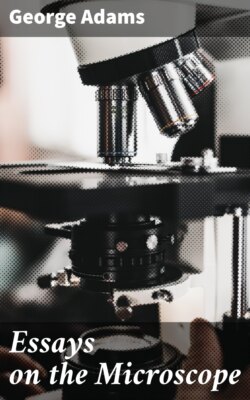Читать книгу Essays on the Microscope - George Comp Adams - Страница 34
На сайте Литреса книга снята с продажи.
OF THE MOST IMPROVED COMPOUND MICROSCOPE, BEING UNIVERSAL IN ITS USES, AND FORMING THE SINGLE, COMPOUND, OPAKE, AND AQUATIC MICROSCOPES.
ОглавлениеTable of Contents
A person much accustomed to observations by the microscope, will readily discern the several advantages of this instrument over the preceding one. Besides its containing an additional quantity of useful apparatus, it is more commodious and complete for the management while observing, as it may instantly be placed in a vertical, oblique, or horizontal situation, turned laterally at the ease of the observer, and the objects viewed by the primary direct light, or reflected as usual, at pleasure. These particulars the following description will clearly shew. I shall not again so fully describe the same apparatus, as the reader must already understand their uses from the preceding references.
Fig. 2 is a representation of this instrument as placed up for use. A B is the compound body. The eye-glasses are contained in an inner tube that slides outwards or inwards, thus altering its distance from a glass at B, and thereby increasing or diminishing the magnifying power, when thought necessary. This body may be screwed on or off to the arm C D, as in the microscope just described; the arm C D may also be moved in any direction over the object. E F is the square stem or bar, on which is moved by the rack-work and pinion M, the stage N I S, to adjust a distinct view to any of the magnifiers, or apparatus used. V is a strong brass pillar with a joint-piece at top, connected to the stem E F; by means of this joint the position of the microscope is readily altered from a vertical to an oblique or horizontal one, as may be desired or found most easy and convenient to the observer, while sitting or standing; it will also enable him to view objects by direct unreflected light; for, when the stem, E F, is put into an horizontal position, the mirrors, O, R, may be drawn off and laid aside. Against or before the condensing lens, U, the common day-light or the light of a candle may then be directed.
At the stage N I S, is a sliding brass spring, N, serving to confine down slips of glass or large sliders, when objects placed thereon are intended to be viewed out of the horizontal position of the stage. A lens, U, called the condensing lens, fixed in a frame connected to a socket, is for condensing and modifying the rays of light reflected from the concave or plane mirror, O, below; it may be set to a proper distance by raising it up by two little screws, one of which is shewn at u. This lens is of considerable use by candle-light, as it serves to fill the whole body, A B, beautifully with light on the object. It is turned aside on a joint pin, when not in use. Six magnifiers are contained in the wheel at P, as in the former microscope. The mirrors, O, below may also be slid upwards or downwards on the stem, by pushing against the screws at r. Thus the stage, lens U, and mirrors below, being all in one axis of motion, admit the adjustment of the distinct view, light, &c. in the most accurate and pleasing manner. When the instrument is packed into its case, the feet, G G H, may all be folded together as one, and the body A B, screwed off, for the advantage of being portable. The body, as screwed off, leaves the instrument a single microscope.
